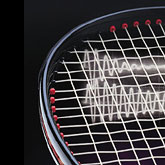How Many Cows Does It Take To String A Tennis Racquet?
 How many cows does it take to string a tennis racquet? According to Professor Rod Cross of the University of Sydney, an expert on the physics and technology of tennis, the answer is 3. Many top professional tennis players still prefer to string their racquets with natural gut instead of synthetics due to natural gut's soft feel, high elasticity and ability to retain tension. However, this is not an alternative for everyone since natural gut is quite expensive. Why? Cross reports there is a great deal of manual time and labor in removing, slitting, washing, twisting, drying and polishing natural gut strings, hence the expense.
How many cows does it take to string a tennis racquet? According to Professor Rod Cross of the University of Sydney, an expert on the physics and technology of tennis, the answer is 3. Many top professional tennis players still prefer to string their racquets with natural gut instead of synthetics due to natural gut's soft feel, high elasticity and ability to retain tension. However, this is not an alternative for everyone since natural gut is quite expensive. Why? Cross reports there is a great deal of manual time and labor in removing, slitting, washing, twisting, drying and polishing natural gut strings, hence the expense.
Natural gut tennis strings are made from a cow's (or sometimes a bull's) small intestine. Part of the digestive tract, the small intestine is a long flexible tube which expands or contracts to accommodate ingested food. The intestine of a cow or sheep is about 120 feet long. However, only the thin outermost stretchy layer of the intestine, the serosa, is used for making tennis strings. Consequently, it requires roughly 3 cow's intestines to string a tennis racquet - not because the intestine is too short but because the serosa is very thin. The serosa is removed and cut into long ribbons which are cleaned through a series of salt and chemical baths. About 18 ribbons are assembled and twisted as a long string and dried under tension in a temperature and humidity controlled room. The string is polished into a smooth, round and clear string. A protective coating (like polyurethane) is added to reduce abrasion and prevent moisture from entering the string.
'The serosa of sheep and pig intestines would also work, however they are used for sausage skins, so the manufacturers prefer to use the more readily available and slightly stronger intestines from cows,' said Cross. 'Many people think that natural gut is made from cats. However, the small intestine of a cat is only 4 feet long and therefore too short to make a tennis string.' According to Cross, the word 'catgut' appears to have evolved from the use of natural gut in a musical instrument called a 'kit' or perhaps from the name of the town in Germany where the strings were made.
About the Author
Jani Macari Pallis, PhD
 Dr. Jani Macari Pallis is the founder of Cislunar Aerospace, Inc. She is
also the creator of two excellent educational sites, The K-8 Aeronautics Internet Textbook, a multi-level interactive learning website, and Wright Again, a chronological history of the Wright Brothers.
Dr. Jani Macari Pallis is the founder of Cislunar Aerospace, Inc. She is
also the creator of two excellent educational sites, The K-8 Aeronautics Internet Textbook, a multi-level interactive learning website, and Wright Again, a chronological history of the Wright Brothers.


